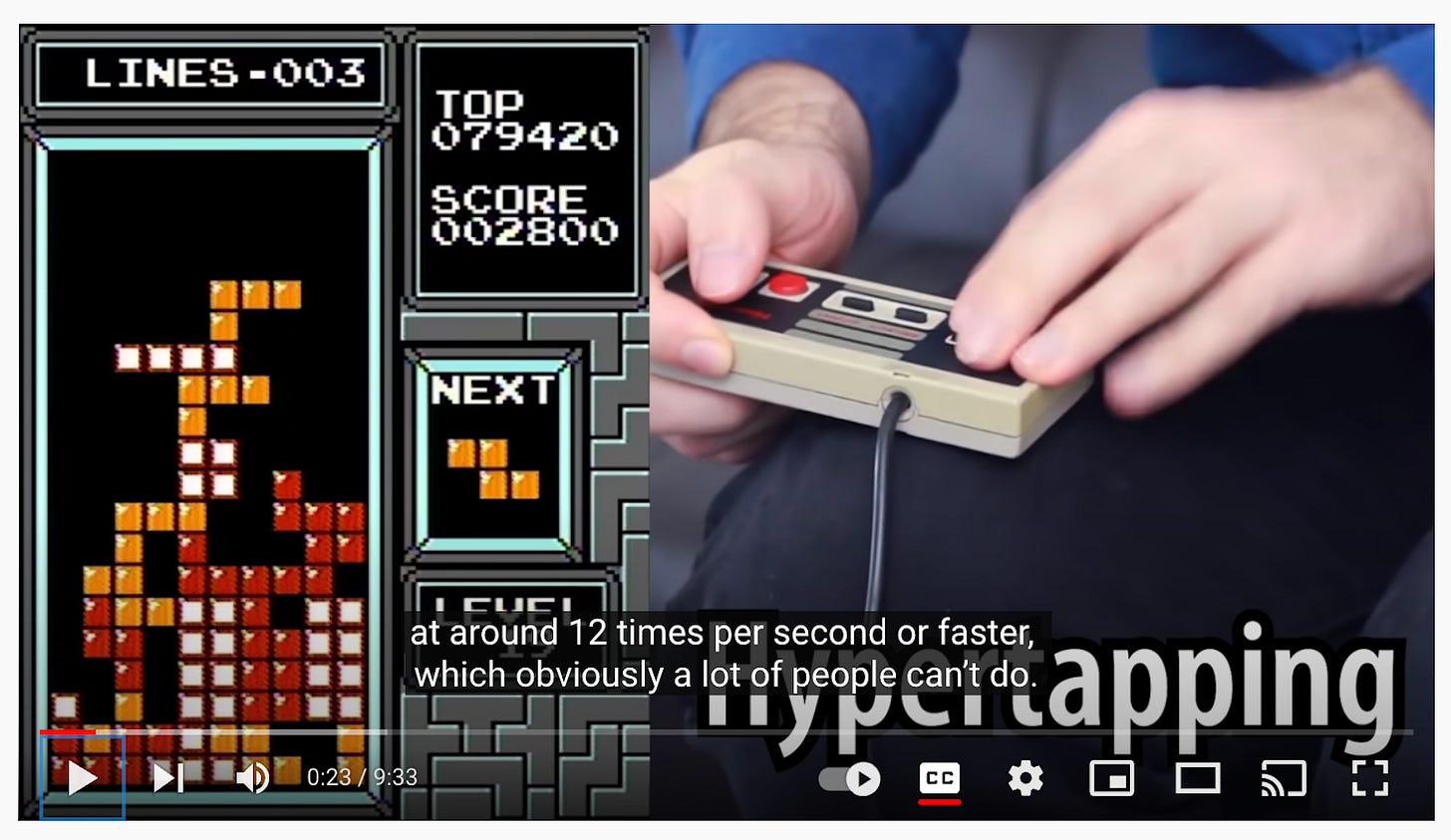The Tetris Edition
On records, hypertappers, and rolling
Noah here. A very fun 2007 story about Tetris records made the rounds a few months back. It’s the tale of a surprise Tetris champion and a throwback to what feels like a fundamentally different age—which, considering it’s about the year the iPhone was introduced, I guess it was.
Why is this interesting?
The world of NES Tetris has evolved quite a bit since 2007—a surprising fact considering we’re talking about a version of the game that Nintendo introduced in 1989. The story, as excellently documented by Chris Karnadi at Polygon, is that folks who grew up flipping shapes pushed it to its limits. Then, around 2018, the kids showed up.
Until then, everyone played Tetris roughly the same way—with both hands on the controller, which sat horizontally between them. For this method, known as DAS (Delayed Auto Shift), you hold down left or right on the directional pad with your thumb to move pieces. The problem is that NES Tetris has a low refresh rate, meaning you’re subject to the game’s constraints to dictate how fast a piece can move left or right.
That was until hypertapping came along. For this technique, you still hold the controller horizontally, but rather than using your thumb, you use your fingers to tap the direction pad much more quickly. This helps break the game’s built-in boundaries and get pieces where they need to go, even when the speed gets out of control.
This blew away the old method, and all the records fell. In 2018, seven-time Tetris world champion Jonas Neubauer was defeated by 16-year-old hypertapper Joseph Saelee.
The next few years were owned by the hypertappers, who dominated tournaments and records. But a new approach has emerged called rolling. To do this, you leave your thumb on the direction pad, but rather than tapping or holding it down, you tap and roll your fingers on the bottom of the controller to push the pad back into your thumb. This allows even faster horizontal movement than the hypertappers could hope to achieve.
And it works. From Polygon:
Rolling has taken over the Tetris world. Most of the top 8 from the 2021 CTWC have switched to rolling in some capacity over the past year in time for the 2022 CTWC in October, including Andy Artiaga, who finished fourth, just behind Saelee. In a monthly Tetris competition this past May, Artiaga won a match that broke the world record for highest combined score in a single game, highest losing score (1.5 million), and highest winning score (2.1 million). Artiaga reached level 58, a full 29 levels after the game’s kill screen.
Beyond being a fun story, there’s a wholesomeness to the whole thing that is refreshing. The videos, the exchange of ideas, and the fun of these tournaments are a nice counterbalance to much of the terrible stuff floating around the internet these days. (NRB)
—
WITI x McKinsey:
An ongoing partnership where we highlight interesting McKinsey research, writing, and data.
The Future of the Workplace. The COVID-19-pandemic caused a tectonic shift in where, when, and how we work. McKinsey experts in real estate, people and organizational performance, and operations are collaborating to help leaders understand how the workplace is changing and how their organizations can best prepare. Read here.
Thanks for reading,
Noah (NRB) & Colin (CJN)
—
Why is this interesting? is a daily email from Noah Brier & Colin Nagy (and friends!) about interesting things. If you’ve enjoyed this edition, please consider forwarding it to a friend. If you’re reading it for the first time, consider subscribing (it’s free!).





